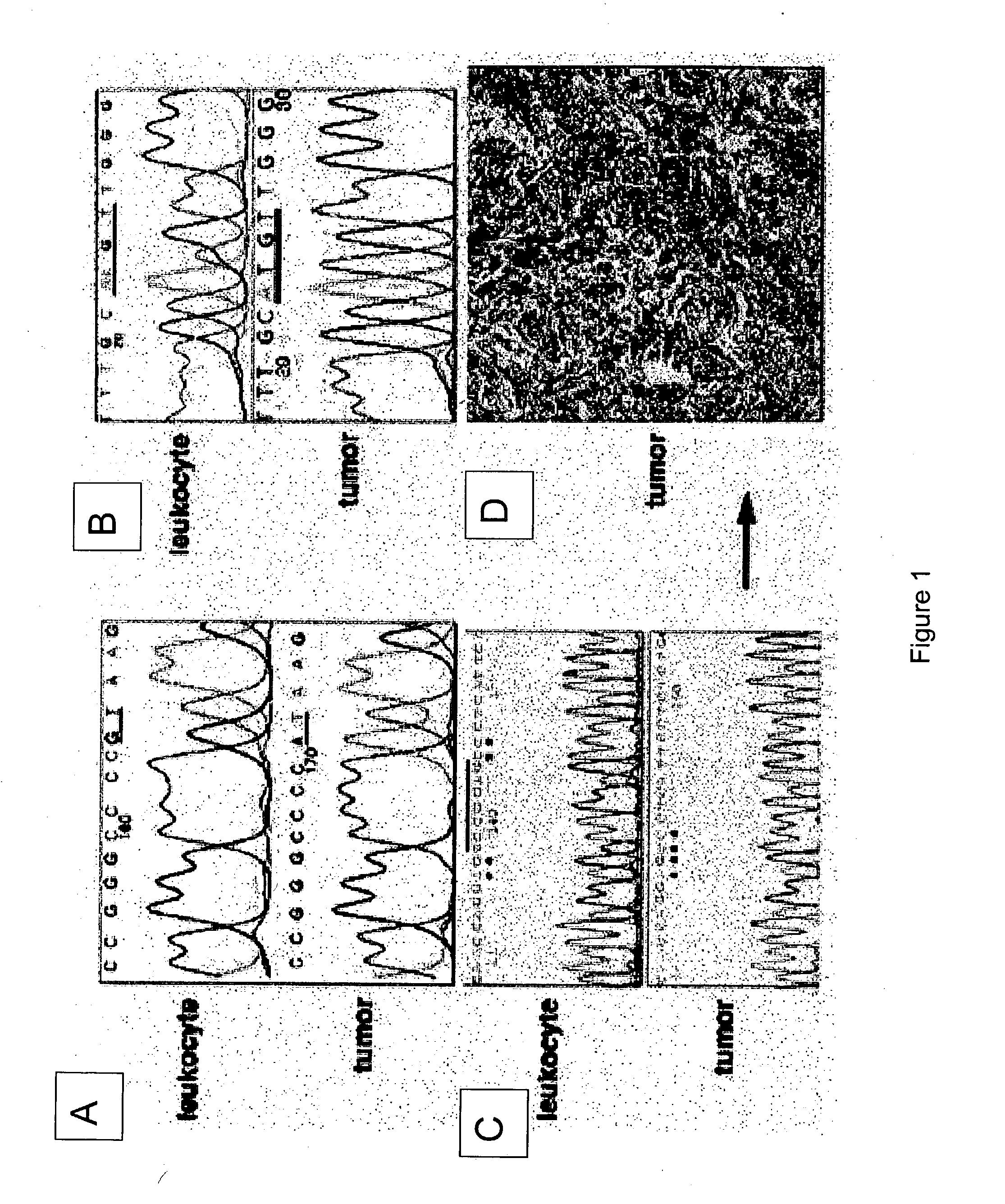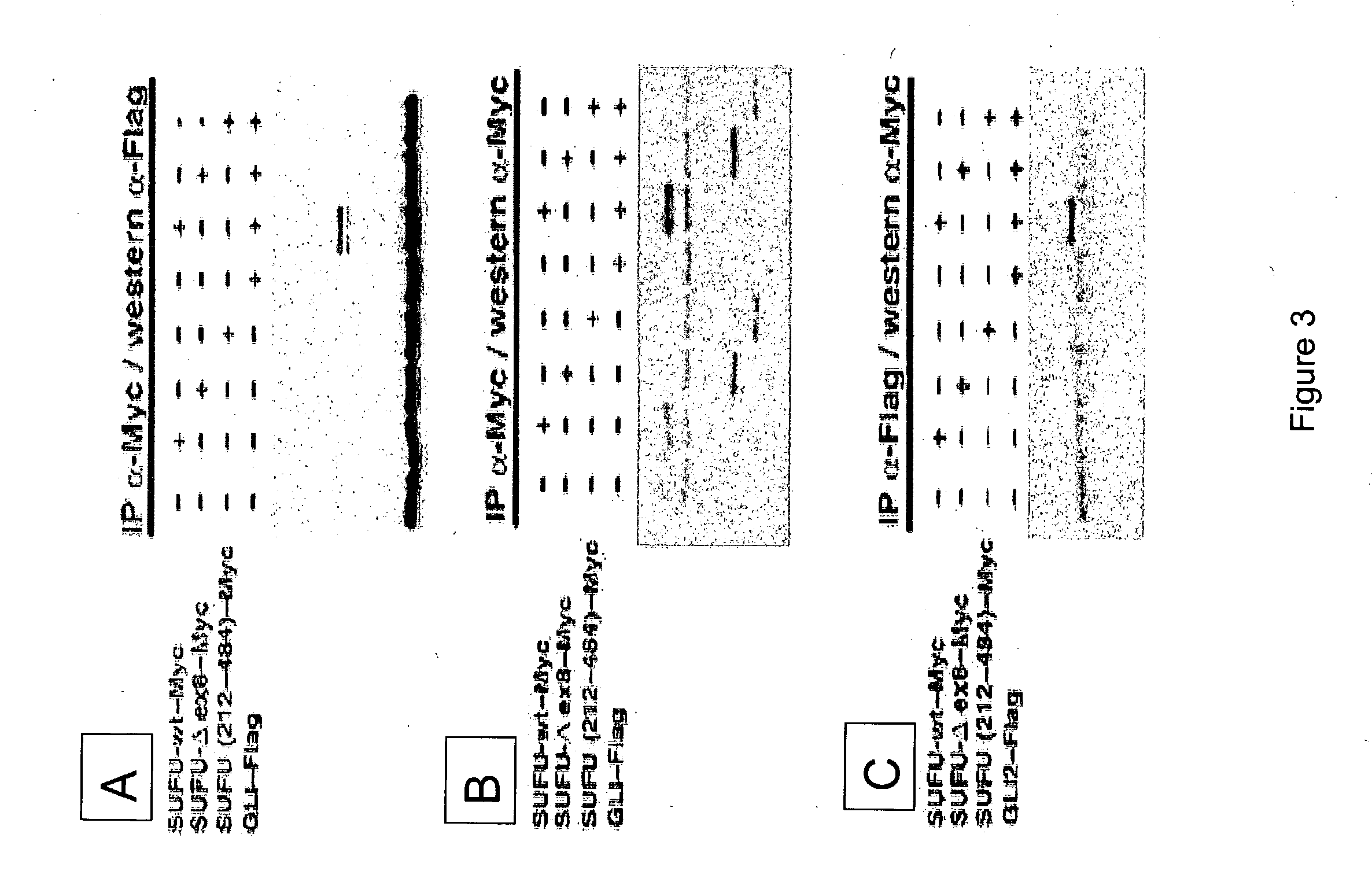Diagnostic and therapeutic uses of SUFU gene
a technology of sufu and gene, applied in the direction of biochemistry apparatus and processes, microbiological testing/measurement, etc., can solve the problem that the survival rate of brain tumors remains lower than for other forms of cancer, and achieve the effect of improving the function of sufu
- Summary
- Abstract
- Description
- Claims
- Application Information
AI Technical Summary
Benefits of technology
Problems solved by technology
Method used
Image
Examples
example 1
Tumor Samples and Isolation of Nucleic Acids
[0085] Samples of pediatric medulloblastoma under the guidelines of the Hospital for Sick Children Research Ethics Board were collected, flash-frozen directly after surgical removal and stored the samples in liquid nitrogen. Additional tumor samples came from the Brain Tumor Tissue Bank (London, Ontario, Canada), the Pediatric Co-operative Human Tissue Network of the US National Cancer Institute (Bethesda, Md.), the Tissue Bank of the Brain Tumor Research Center at UCSF (San Francisco, USA) and the Children's National Medical Center (Washington, USA). Individuals with NBCCS but no mutations in PTCH were identified in a National Cancer Institute study (6,26) or at the University of Queensland (Australia) (27). In every case, affected individuals or their guardians provided informed consent and / or took part in protocols approved by local or national institutional review boards.
[0086] Total RNA was isolated using Trizol reagent (Gibco-BRL),...
example 2
Determination of Genomic Structure and Chromosomal Location of SUFU and BTRC (Beta-Transducin Repeat-Containing Protein Gene)
[0087] Using SUFU cDNA as a probe, clones 124G18 and 2F13 were isolated from the Roswell Park Cancer Institute human genomic BAC library, and subclones sequenced to determine intron-exon boundaries. PCR was used to screen a BAC library specific for chromosome 10q (Genome Systems) for clones containing human BTRC and carried out radiation hybrid mapping of SUFU and BTRC with the GB4 panel (Research Genetics). All primer sequences are available on request.
[0088] cDNAs were generated using SuperScript II RT (Gibco-BRL) with both oligo-dt and SUFU-specific primers. Two nested PCRs were performed to amplify exons 1-4 and exons 4-12, respectively, the PCR products were subcloned with a TA cloning Kit (Invitrogen) and sequenced using the Cy-5 / 5.5-labeled M13 primer.
example 3
Fluorescence in situ Hybridization (FISH)
[0089] Lymphocytes were cultured from peripheral blood or cell lines infected with Epstein—Barr virus and incubated the cells for 30 min with colcemid (0.1 μg / ml) before harvesting. A contiguous series of BAC clones from chromosome 10q24-q25 was labelled with biotin using the BioNick Labeling system, and BAC RP11-59D04 on chromosome 10p15 was labelled with digoxigenin as a control. FISH signals were detected with fluorescein-avidin D (Vector) and fluorescein-labeled antibody against avidin D (Vector) for biotin-labeled probes, and with antibody against digoxigenin, digoxigenin-labeled antibody against mouse Ig, and rhodamine-labeled antibody against digoxigenin (Boehringer Mannheim) for digoxigenin-labeled probes.
PUM
| Property | Measurement | Unit |
|---|---|---|
| Mass | aaaaa | aaaaa |
| Therapeutic | aaaaa | aaaaa |
| Electrophoretic mobility | aaaaa | aaaaa |
Abstract
Description
Claims
Application Information
 Login to View More
Login to View More - R&D
- Intellectual Property
- Life Sciences
- Materials
- Tech Scout
- Unparalleled Data Quality
- Higher Quality Content
- 60% Fewer Hallucinations
Browse by: Latest US Patents, China's latest patents, Technical Efficacy Thesaurus, Application Domain, Technology Topic, Popular Technical Reports.
© 2025 PatSnap. All rights reserved.Legal|Privacy policy|Modern Slavery Act Transparency Statement|Sitemap|About US| Contact US: help@patsnap.com



